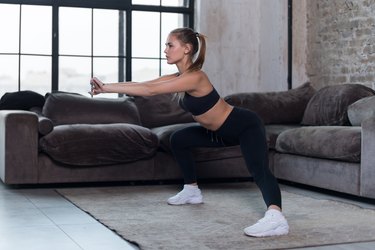
People living with cerebellar ataxia often have impaired coordination in the torso or limbs. Ataxia exercises may help to improve their balance and coordination while reducing injury risk. It's recommended you work with a physical therapist and follow a custom exercise plan.
Cerebellar Ataxia Overview
Video of the Day
Ataxia is a degenerative neurological disease that affects a person's ability to walk, speak, eat and move around. It's estimated that approximately 150,000 people in the U.S. are living with this disorder, reports the National Ataxia Foundation.
Video of the Day
Most sufferers experience a progressive deterioration of their fine motor skills as well as gait abnormalities, cardiovascular problems, tremors and poor balance. They may not be able to move around without a wheelchair and assistive devices.
Several forms of this disorder exist. Cerebellar ataxia, for example, results from injuries or diseases affecting the cerebellum, a brain area responsible for muscle movement and coordination. Its symptoms may include walking problems, slurred speech, poor balance, uncoordinated eye movements and difficulty with fine motor tasks, such as writing or picking up small items.
Your doctor may order spinal tap and nerve conduction tests to determine the exact cause of your symptoms. Nerve conduction tests, for instance, are used to diagnose nerve disorders and measure the electrical activity in your muscles and nerves. The procedure involves placing several electrodes over a nerve, as well as a recording electrode over the muscles controlled by that nerve. This allows the doctor to send small electrical impulses to the nerve and assess your symptoms, explains Cedars Sinai.
Treatment depends on the cause of the disease and may include medication and physical therapy, among other measures. Physiotherapy is particularly important as it may help improve balance, coordination and gait, states The Royal Victorian Eye and Ear Hospital. This disease cannot be cured, but you can manage its symptoms. The National Ataxia Foundation emphasizes the importance of staying active for as long as possible.
Ataxia Exercises To Try
What exercises you can do depends on your ability to move and the form of the disease. For example, physical therapy for pediatric ataxia may include a combination of at-home exercises, school-based physical education and hospital-based physiotherapy, according to a review published in The Cerebellum in August 2019. This approach has been shown to reduce the number of falls. Computer-assisted training and treadmill training in a clinical setting may help too.
However, the above review is based on small studies, so further investigation is needed to confirm its findings. Your physiotherapist is the only one who can recommend an appropriate exercise plan.
The National Ataxia Foundation recommends several exercises that you may use as a starting point. Perform two or three sets of eight to 10 repetitions per exercise. As you progress, try to gradually increase the number of reps to 15. Aim for two or three exercises per session, plus walking, cycling, endurance training and movements that build muscular strength.
Move 1: Sit to Stand
- Sit on a chair or bench with your feet hip-width apart.
- Lean forward and get into an upright position without using your arms.
- Return to a seated position with a slow, controlled motion.
Move 2: Kneeling Press Up
- Get on your knees, keeping your arms at your sides.
- Squeeze your glutes and use them to propel your body to a high kneeling position.
- Return to a low kneeling position and repeat.
Move 3: Side Steps
- Stand with your feet hip-width apart and your arms at your sides.
- Take a big step to the right side.
- Return to the starting position and repeat.
- Perform 20 repetitions for each leg, recommends the National Ataxia Foundation.
Move 4: Lying Rotation
- Lie on your back with your knees bent. Spread your arms to the sides.
- Tilt both your knees to one side.
- Return to the starting position and repeat.
- Perform 10 repetitions on each side.
Working Out at Home
According to a small study featured in Disability and Rehabilitation in February 2017, ataxia exercises should be enjoyable and challenging at the same time. For many sufferers, physical therapy is their only hope. As the researchers note, physiotherapists should try to develop exercise plans that fit into patients' everyday lives.
The National Ataxia Foundation shares some tips on how to do this. Basic activities such as repeatedly pouring water from one cup to another or throwing and catching a ball may help improve hand-arm coordination. If you want to try simple physical therapy for pediatric ataxia, you can ask your child to pile up little toy bricks or collect marbles, seashells and other items in small jars.
- National Ataxia Foundation: "What Is Ataxia?"
- The Royal Victorian Eye and Ear Hospital: "Cerebellar Ataxia"
- The Cerebellum: "Exercise and Physical Therapy Interventions for Children with Ataxia: A Systematic Review"
- National Ataxia Foundation: "11 Exercises for Ataxia Patients"
- National Ataxia Foundation: "Coordinative Physiotherapy for Patients With Ataxia"
- Disability and Rehabilitation: "The Meanings of Physiotherapy and Exercise for People Living With Progressive Cerebellar Ataxia: An Interpretative Phenomenological Analysis"
- Cedars Sinai: "Spinal Diagnostics: Nerve Conduction Studies"